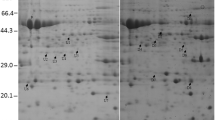Abstract
A new osmotin-like protein gene from Solanum nigrum L. var indica (SindOLP) was cloned and overexpressed in Escherichia coli. The full-length intron-less gene is 744 bp, encoding a mature protein of 247 amino acids with a molecular mass of 26 kDa. The protein has an N-terminal cleavable signal sequence of 21 amino acids. There is the Thaumatin family signature pattern, with one each of amidation, N-myristoylation, casein kinase II phosphorylation, tyrosine kinase phosphorylation, and protein kinase C phosphorylation sites. Hydropathy plot showed that it has six transmembrane helices. It has antifungal activity and can permeabilize fungal hyphae and spores. SindOLP is most active at pH 8, 25 °C and its antifungal activity is retained after 75 °C for 30 min. SindOLP inhibits fungal spore germination. The protein however lacks glucanase activity. The potential for SindOLP in developing fungus-resistant, transgenic crops is discussed.








Similar content being viewed by others
References
Singh, N. K., Kumar, K. R. R., Kumar, D., Shukla, P., & Kirti, P. B. (2013). Characterization of a pathogen induced thaumatin-like protein gene AdTLP from Arachis diogoi, a wild peanut. PLoS One, 8(12), e83963. doi:10.1371/journal.pone.0083963.
Das, M., Chauhan, H., Chhibbar, A., RizwanulHaq, Q. M., & Khurana, P. (2011). High efficiency transformation and selective tolerance against biotic and abiotic stress in mulberry, Morus indica cv. K2 by constitutive and inducible expression of tobacco osmotin. Transgenic Research, 20, 231–246.
Patade, V. Y., Khatri, D., Kumari, M., Grover, A., Gupta, S. M., & Ahmed, Z. (2013). Cold tolerance in osmotin transgenic tomato (Solanum lycopersicum L.) is associated with modulation in transcript abundance of stress responsive genes. Springer Plus, 2, 117.
Goel, D., Singh, A. K., Yadav, V., Babbar, S. B., & Bansal, K. C. (2010). Overexpression of osmotin gene confers tolerance to salt and draught stresses in transgenic tomato (Solanum lycopersicum L.). Protoplasma, 245, 133–141.
Campos, M. D., Silva, M. S., Magalhaes, C. P., Ribeiro, S. G., Sarto, R. P. D., Vieira, E. A., & de Sa Grossi, M. F. (2008). Expression in Escherichia coli, purification, refolding and antifungal activity of an osmotin from Solanum nigrum. Microbial Cell Factories, 7, 7.
Freitas, C. D. T., Lopes, J. L. S., Beltramini, L. M., Oliveira, R. S. B., Oliveira, J. T. A., & Ramos, M. V. (2011). Osmotin from Calotropis procera latex: New insights into structure and antifungal properties. Biochimica et Biophysica Acta, 1808, 2501–2507.
Tzou, Y. M., Huang, T. S., Huggins, K. W., Chin, B. A., Simonne, A. H., & Singh, N. K. (2011). Expression of truncated tobacco osmotin in Escherichia coli: purification and antifungal activity. Biotechnology Letters, 33, 539–543.
Subramanyam, K., Arun, M., Mariashibu, T. S., Theboral, J., Rajesh, M., Singh, N. K., et al. (2012). Overexpression of tobacco osmotin (Tbosm) in soybean conferred resistance to salinity stress and inhibit infections. Planta, 236, 1909–1925.
Jami, S. K., Anuradha, T. S., Guruprasad, L., & Kirti, P. B. (2007). Molecular, biochemical and structural characterization of osmotin-like protein from black nightshade (Solanum nigrum). Journal of Plant Physiology, 164, 238–252.
Vasavirama, K., & Kirti, P. B. (2012). Increased resistance to late leaf spot disease in transgenic peanut using a combination of PR genes. Functional & Integrative Genomics, 12, 625–634.
Chowdhury, S., Basu, A., Raychaudhuri, T., & Kundu, S. (2014). In-vitro characterization of the behaviour of Macrophomina phaseolina (Tassi) Goid at the rhizosphere and during early infection of roots of resistant and susceptible varieties of sesame. European Journal of Plant Pathology, 138, 361–375.
Chowdhury, S., Basu, A., & Kundu, S. (2014). A new high-frequency Agrobacterium-mediated transformation technique for Sesamum indicum L. using de-embryonated cotyledon as explant. Protoplasma, 251, 1175–1190.
Liang, X. Q., Holbrook, C. C., Lynch, R. E., & Guo, B. Z. (2005). β-1, 3-Glucanase activity in peanut seed (Arachis hypogaea) is induced by inoculation with Aspergillus flavus and co-purifies with a conglutin-like protein. Phytopathology, 95, 506–511.
Beer, A. D., & Vivier, M. A. (2008). Vv-AMP1, a ripening induced peptide from Vitis vinifera shows strong antifungal activity. BMC Plant Biology, 8, 75.
Monteiro, S., Barakat, M., Piçarra-Pereira, M. A., Teixeira, A. R., & Ferreira, R. B. (2003). Osmotin and thaumatin from grape: A putative general defense mechanism against pathogenic fungi. Phytopathology, 93, 1505–1512.
Acknowledgments
This work was partially supported by Department of Biotechnology (DBT), Ministry of Science and Technology, Government of India. S. Chowdhury and A. Basu received University Grants Commission (UGC, New Delhi)-NET and Council for Scientific and Industrial Research (CSIR, New Delhi)-NET senior research fellowship, respectively.
Author information
Authors and Affiliations
Corresponding author
Electronic supplementary material
Below is the link to the electronic supplementary material.
Rights and permissions
About this article
Cite this article
Chowdhury, S., Basu, A. & Kundu, S. Cloning, Characterization, and Bacterial Over-Expression of an Osmotin-like Protein Gene from Solanum nigrum L. with Antifungal Activity Against Three Necrotrophic Fungi. Mol Biotechnol 57, 371–381 (2015). https://doi.org/10.1007/s12033-014-9831-4
Published:
Issue Date:
DOI: https://doi.org/10.1007/s12033-014-9831-4




